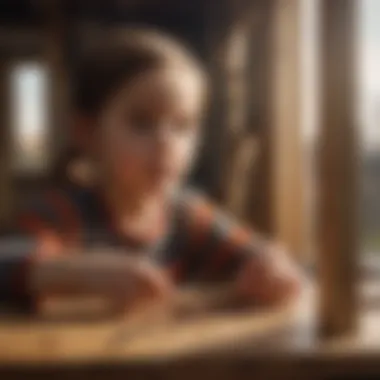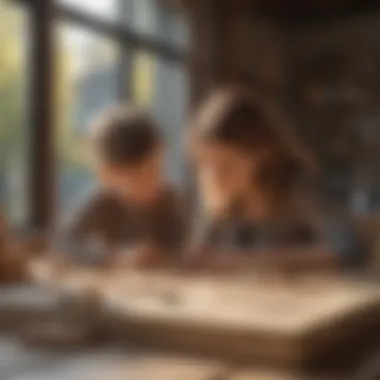Unleashing Creativity: A Guide to Children's Wood Building Kits


Playhouse Overview
When it comes to children's wood building kits, playhouses stand out as versatile and engaging options for young minds. Playhouses come in various types, ranging from simple cottages to intricate castles, offering children a diverse range of imaginative play settings.
Features and Benefits
Playhouses boast essential features that contribute to their appeal for both children and parents. Their durable construction ensures longevity, with sturdy materials that can withstand active play. Safety measures such as rounded edges and non-toxic finishes provide peace of mind for caregivers. Moreover, playhouses ignite children's creativity and stimulate their imaginations, serving as blank canvases for inventive play scenarios.
- Durability When selecting a playhouse, durability is a paramount consideration. Opt for models constructed from robust wood or plastic materials that can withstand rough play and outdoor elements.
- Safety Ensure the playhouse adheres to safety standards, with features like rounded edges, secure fastenings, and non-toxic paints or finishes for child-friendly play.
- Imagination Stimulation Playhouses spark imaginative play, offering children a space to invent stories, role-play scenarios, and explore endless creative possibilities.
Buying Guide
Choosing the perfect kids playhouse involves assessing various factors to meet your child's preferences and practical needs. Consider elements such as material, size, theme, and interactive features when browsing through playhouse options.
- Material Decide between wooden or plastic playhouses based on your desired level of sturdiness, aesthetics, and maintenance requirements.
- Size Select a playhouse size that fits your available space indoors or outdoors, providing sufficient room for children to play comfortably.
- Theme Opt for a playhouse theme that aligns with your child's interests, whether it be a fairy-tale castle, rustic cabin, or modern urban dwelling.
- Interactive Elements Enhance your child's play experience with interactive features like doors, windows, play kitchens, slides, or climbing walls.
Maintenance Tips
To prolong the lifespan of your child's playhouse, proper care and maintenance are essential. Implement simple cleaning routines and storage practices to keep the playhouse in top condition for long-lasting enjoyment.
- Cleaning Instructions Regularly wipe down the playhouse with mild soap and water to remove dirt and debris. Avoid harsh chemicals that may damage the finish or structural integrity.
- Storage Recommendations During periods of non-use or inclement weather, store the playhouse in a dry, sheltered area to prevent deterioration from exposure to moisture or extreme temperatures.
Customization Options
For families seeking a personalized touch to their child's play space, customizable playhouse choices offer a spectrum of creative opportunities.
- Paint Your Own Playhouse Kits: Artistic Expression for Kids Encourage artistic endeavors with paint-your-own playhouse kits, allowing children to add vibrant colors and unique designs to their playhouse.
- DIY Playhouse Kits: Family Bonding Through Building Embark on a family building project with DIY playhouse kits, fostering bonding experiences as you assemble and customize the play space together.
- Build Your Own Playhouse: Tailored Designs for Personalized Play Tailor the playhouse design to your child's preferences by opting for build-your-own kits that enable customization of features, colors, and layouts.
- Unique Playhouse Accessories to Enhance the Play Space Explore accessory options such as curtains, furniture sets, flower boxes, and signage to adorn and enhance the playhouse's aesthetic and functionality.
Introduction to Children's Wood Building Kits
Children's wood building kits are a transformative educational tool that offers a myriad of benefits in fostering creativity, spatial reasoning, and fine motor skills in young individuals. In this comprehensive guide, we delve into the enriching world of wood building kits, shedding light on their significance in the developmental journey of children. From understanding the educational value to exploring the various types available, this article aims to provide valuable insights for parents, caregivers, and educators looking to empower children through hands-on learning experiences with wood.
Understanding the Educational Value
The Role of Wood Building Kits in Child Development
Wood building kits play a pivotal role in enhancing children's cognitive and physical development. By engaging in hands-on construction activities, children are not only exercising their creativity but also honing essential problem-solving and critical thinking skills. The tactile nature of wood encourages sensory exploration, thereby stimulating multiple areas of development simultaneously. The versatility of wood building kits allows children to explore diverse methods of assembly, fostering adaptability and resilience.
Enhancing Creativity and Imagination
Wood building kits provide a blank canvas for children to unleash their imaginative prowess. Through the process of conceptualizing, designing, and constructing unique creations, children develop a deep sense of ownership and pride in their work. This creative freedom cultivates a mindset of innovation and ingenuity, preparing children to approach challenges with inventiveness and resourcefulness.


Improving Fine Motor Skills
The precise manipulation of wooden components in building kits refines children's fine motor skills, enhancing dexterity and coordination. Assembling tiny pieces to create complex structures demands concentration and attention to detail, further honing hand-eye coordination and finger strength. The repetitive action of connecting wooden parts instills patience and perseverance, instilling a sense of accomplishment as children witness their creations taking shape.
Types of Children's Wood Building Kits
Basic Building Block Sets
Basic building block sets serve as the foundation for young builders to experiment with fundamental construction principles. These sets typically consist of uniform wooden blocks that can be interlocked to form structures, encouraging basic spatial awareness and engineering concepts. The simplicity of basic block sets appeals to beginners, providing a structured introduction to the world of wood building.
Advanced Construction Sets
Advanced construction sets present intricate challenges for seasoned builders seeking to expand their skills. These kits often feature specialized components such as gears, pulleys, and connectors that enable the creation of complex mechanical contraptions. By incorporating elements of engineering and physics, advanced sets offer a more in-depth exploration of STEM concepts in a hands-on environment.
Themed Playhouse Kits
Themed playhouse kits infuse imaginative storytelling elements into the building process, allowing children to craft immersive settings for their imaginative play. Whether building a castle, a treehouse, or a pirate ship, these kits spark role-playing scenarios that engage children in creative narratives. The themed nature of these kits not only enhances structural design skills but also encourages storytelling and character development.
Benefits of Wood Building Kits Over Other Toys
Durable and Long-Lasting
One of the key advantages of wood building kits is their exceptional durability and longevity. Unlike plastic toys that may break or wear out over time, wooden components are robust and resistant to wear, ensuring sustained enjoyment for children. The sturdiness of wood promotes sustainability, reducing the need for frequent replacements and minimizing environmental impact.
Promoting Sustainable Play
Wood building kits align with eco-conscious practices by utilizing natural materials that are renewable and biodegradable. By choosing wood as the primary construction medium, parents can instill values of environmental stewardship and resourcefulness in their children. Sustainable play experiences with wood building kits cultivate an appreciation for the earth and encourage mindful consumption habits from a young age.
Encouraging Problem-Solving Skills
Wood building kits offer a platform for children to engage in hands-on problem-solving activities that challenge their logical reasoning and spatial awareness. The self-directed nature of building with wood empowers children to experiment, iterate, and troubleshoot independently, fostering resilience and adaptability. Navigating obstacles during construction hones critical thinking skills, teaching children to approach challenges with a systematic and innovative mindset.
Choosing the Right Wood Building Kit
Factors to Consider
Age Appropriateness
Age appropriateness plays a pivotal role in the selection process of a wood building kit. It is essential to match the complexity and detail of the kit with the child's age to promote engagement and prevent frustration. Choosing a kit that aligns with a child's developmental stage ensures optimal learning and skill-building opportunities. The unique feature of age appropriateness lies in its ability to scaffold a child's learning experiences, building upon existing skills while introducing new challenges gradually. Understanding the age appropriateness of a wood building kit is crucial in fostering a child's cognitive and motor skill development.
Complexity Level
The complexity level of a wood building kit determines the degree of challenge and intricacy involved in the construction process. Opting for a kit with an appropriate complexity level allows children to navigate through tasks that are neither too simple nor overwhelming, encouraging problem-solving and critical thinking skills. The key characteristic of complexity level is its role in striking a balance between stimulating a child's creativity and maintaining an achievable task structure. By selecting a kit with an optimal complexity level, children can develop perseverance and attention to detail while enhancing their spatial awareness.


Quality of Materials
The quality of materials used in a wood building kit contributes significantly to the overall durability, safety, and aesthetic appeal of the finished structure. Prioritizing high-quality materials ensures longevity and resistance to wear and tear, providing children with a reliable and safe construction experience. Emphasizing the importance of quality materials in wood building kits not only enhances the tactile experience for children but also promotes sustainable play practices. The unique feature of quality materials lies in their ability to withstand repeated use and environmental influences, guaranteeing a lasting and enjoyable playtime for children.
Top Recommendations
Brand Comparison
When evaluating wood building kits, conducting a thorough brand comparison enables parents and educators to assess reputability, craftsmanship, and innovation across different manufacturers. Comparing brands allows for the identification of key attributes such as quality standards, design diversity, and instructional support, aiding in the selection of a kit that aligns with specific preferences and educational goals. The key characteristic of brand comparison is its function in guiding consumers towards renowned and trusted brands that consistently deliver exceptional wood building kits. By scrutinizing various brands, individuals can make informed decisions that prioritize quality craftsmanship and instructional value.
Customer Reviews
Customer reviews serve as invaluable insights into the practical experiences and satisfaction levels of individuals who have purchased and utilized specific wood building kits. Examining customer reviews helps potential buyers gauge factors such as ease of assembly, durability, educational value, and overall product performance. The key characteristic of customer reviews is their ability to offer firsthand perspectives on the usability and enjoyment that a wood building kit provides. By considering a range of customer feedback, parents and guardians can gain a comprehensive understanding of a kit's strengths and potential limitations, aiding them in selecting an optimal kit for their child.
Safety Standards
Prioritizing safety standards when choosing a wood building kit is paramount in safeguarding children during play and construction activities. Kits that adhere to stringent safety regulations ensure that children engage in designing and building structures without unnecessary risks. The key characteristic of considering safety standards is the assurance of age-appropriate materials, secure construction elements, and hazard-free components within the kit. By selecting kits that meet or exceed safety standards, parents can create a safe and supervised environment for children to explore their creativity and problem-solving skills.
DIY vs. Pre-Made Kits
Customization Options
The presence of customization options in wood building kits grants children the freedom to personalize their creations, fostering a sense of ownership and creative expression. Kits that feature customizable elements enable children to experiment with design variations, encouraging imaginative thinking and individuality. The key characteristic of customization options is their capacity to spark innovation and divergent thinking, allowing children to engage in open-ended play scenarios. By opting for kits that offer customization, children can enjoy a personalized building experience that complements their unique preferences and interests.
Time and Effort Consideration
Considering the time and effort required for both assembly and play is crucial when deciding between DIY and pre-made wood building kits. DIY kits often involve more extensive construction processes that demand patience and persistence, offering children the opportunity to build skills incrementally. In contrast, pre-made kits provide instant gratification and reduced setup time, catering to children who prefer immediate engagement. The key characteristic of time and effort consideration is its influence on the pacing and involvement levels of children during the building process. By weighing the time and effort aspects, parents can choose a kit that aligns with a child's attention span and enthusiasm, maximizing enjoyment and skill development.
Cost Analysis
Conducting a cost analysis of wood building kits involves evaluating the financial investment relative to the kit's quality, durability, and educational value. Comparing the cost of DIY and pre-made kits against their features and benefits enables informed decision-making regarding budget allocations. The key characteristic of cost analysis is its role in balancing affordability with quality, ensuring that the chosen kit offers long-term engagement and developmental benefits. By discerning the cost implications of different kits, parents can select an option that meets both their budget constraints and a child's learning needs, optimizing the overall value and educational potential of the wood building experience.
Tips for Engaging Children with Wood Building Kits
Engaging children with wood building kits is crucial for their development and enjoyment. By actively involving them in the building process, children can enhance their creativity, problem-solving skills, and overall cognitive abilities. Understanding how to maximize their engagement with these kits can lead to fulfilling and enriching play experiences.
Encouraging Active Participation
Setting Up a Designated Building Area
Setting up a designated building area provides children with a dedicated space for their creativity to flourish. It allows them to focus on the task at hand and promotes a sense of ownership over their projects. By having a specific area for building, children can easily access their kits and materials, encouraging frequent and spontaneous building sessions. The organization and layout of this area play a significant role in shaping a child's building experience.
Incorporating Storytelling Elements


Incorporating storytelling elements into wood building activities adds a layer of imagination and narrative to the process. By encouraging children to create stories around their creations, they develop language skills, emotional intelligence, and a deeper connection to their projects. Storytelling also fosters creativity and critical thinking as children link their narratives to the structure and design of their creations.
Joining in the Building Process
Actively participating in the building process alongside children not only strengthens the bond between adults and kids but also promotes collaborative learning. Adults can provide guidance, reinforce safety measures, and inspire creativity through their involvement. This shared experience creates a supportive environment for children to experiment, learn new skills, and take pride in their finished projects.
Promoting Continuous Learning
Introducing New Challenges Gradually
Gradually introducing new challenges to children ensures a continuous learning curve. By incrementally increasing the complexity or scope of building projects, children stay engaged and motivated to explore new techniques and ideas. This approach cultivates a growth mindset, instills perseverance, and encourages children to step out of their comfort zones while building with wood kits.
Exploring Different Building Techniques
Encouraging children to explore various building techniques enhances their spatial awareness, problem-solving abilities, and fine motor skills. By experimenting with different methods such as stacking, interlocking, or balancing pieces, children develop a deeper understanding of structural integrity and design principles. Diversifying their building approaches broadens their creativity and adaptability in constructing unique creations.
Incorporating Educational Themes
Incorporating educational themes into wood building activities elevates the learning potential of playtime. By connecting building projects to educational concepts like mathematics, science, or history, children engage with subjects in a hands-on and interactive way. This integration nurtures a love for learning, stimulates curiosity, and reinforces academic knowledge outside traditional classroom settings.
Ensuring Safe and Supervised Play
Implementing Safety Guidelines
Prioritizing safety guidelines while children engage with wood building kits is paramount to a positive and secure play experience. Establishing clear rules, such as using age-appropriate tools, wearing protective gear, and maintaining a clean workspace, safeguards children from potential hazards. Enforcing safety practices not only protects their physical well-being but also teaches them responsibility and respect for tools and materials.
Monitoring Playtime Activities
Regularly monitoring children's playtime activities with wood building kits allows adults to provide guidance, intervene when necessary, and observe progress. By staying attentive to the building process, adults can offer assistance, address challenges, and celebrate achievements with children. This active involvement demonstrates support, builds confidence, and ensures a nurturing environment for constructive play.
Storing Kits Properly
Properly storing wood building kits prolongs their lifespan, maintains organization, and prevents misplacement of pieces. By designating a specific storage area for kits, children learn the importance of tidiness and respect for their belongings. Securing kits in durable containers or shelves not only keeps components intact but also facilitates easy access for future building sessions. Establishing good storage habits promotes responsibility, independence, and care for the tools and materials used in building activities.
Conclusion
Embracing the World of Wood Building Kits
Summary of Benefits:
The essential aspect of the summary of benefits lies in its multifaceted approach towards promoting holistic child development. These kits serve as catalysts for enhancing creativity, fostering critical thinking, and honing fine motor skills. The structured yet open-ended nature of wood building kits allows children to explore their imagination while simultaneously developing hand-eye coordination and spatial awareness. A key characteristic of the summary of benefits is its adaptability across various age groups, making it a versatile and enduring choice for children of different developmental stages. The unique feature of the summary of benefits is the hands-on experience it offers, which enhances tactile learning and promotes self-expression. While undoubtedly advantageous in promoting creativity and skill development, a potential disadvantage lies in the need for supervision to ensure safety and prevent any mishaps.
Impact on Child Development:
The impact of wood building kits on child development is profound, emphasizing experiential learning and practical skill-building. By engaging in hands-on construction activities, children not only enhance their problem-solving abilities but also cultivate patience, concentration, and attention to detail. The key characteristic of this impact is the balance between structured play and free-form creation, encouraging children to think critically while still enjoying the process of building. This approach not only boosts confidence but also fosters a sense of accomplishment and pride in completing a project. The unique feature of this impact is its long-term impact on cognitive development, as children who engage with wood building kits tend to exhibit higher levels of creativity and spatial intelligence. While highly beneficial for child development, a potential disadvantage could be over-reliance on instructions, limiting creative thinking and exploration.
Future Trends in Educational Toys:
The future trends in educational toys are heading towards a more hands-on and experiential approach, with an emphasis on promoting STEM skills and creativity. Wood building kits are positioned as a leading contender in this evolution, offering a perfect blend of educational value and interactive play. The key characteristic of these future trends is the integration of technology to enhance traditional play, combining the tangible benefits of hands-on building with digital enhancements for a more immersive experience. This synergy not only elevates the learning potential but also caters to the evolving preferences of tech-savvy children. The unique feature of these future trends is the focus on sustainability and eco-friendliness, aligning with the growing awareness of environmental responsibilities among children and parents alike. While undeniably advantageous in terms of skill development and engagement, a potential disadvantage could be the reliance on screens and devices, potentially limiting real-world interaction and sensory experiences.



